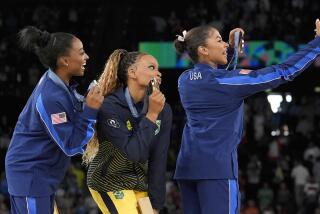School Leadership: Slow, Steady Progress
- Share via
The number of female presidents of U.S. colleges and universities has almost doubled in the last 10 years. Nevertheless, at this rate, said the Office of Women in Higher Education of the American Council on Education, there will not be an equal number of female and male college presidents until 2070.
The near-doubling represents small numbers: In the nation’s more than 3,000 institutions of higher education, the number of female college presidents grew from 148 in 1975 to 286 in 1984, with an average gain of 14 positions a year. Although most of these women head small schools and almost half of them head two-year institutions, there has been an increase in the number who head large colleges and universities. In 1975, only 3% of the female presidents led large institutions, and 10 years later, 27% of female presidents had their jobs at large schools.
While women have been inching ahead in executive jobs in higher education, they have been falling behind in athletic coaching jobs.
Ironically, this may be a result of the growing prestige of women’s sports and Title IX, the federal law that prohibits sex discrimination in education.
The Washington-based Project on Equal Education Rights surveyed intercollegiate athletics programs nationally, and found that in 1983-84 more than 86.5% of women’s intercollegiate programs were supervised by men, up from 80% in 1980.
“The new-found popularity of girls’ and women’s sports may have given rise to an all-too-familiar phenomenon--an activity that is perceived to be important is more likely to be directed by men,” the report said. Also, after Title IX integrated a number of college athletic programs, female coaches, for the first time, had to compete with men for the same jobs.
The findings were part of the organization’s recently completed state-by-state survey of the status of women and girls in education. The survey, “The PEER Report Card: Update on Women and Girls in America’s Schools,” looks at four areas of nontraditional achievement for women that have been indicators of whether women are moving ahead in education: participation in interscholastic sports, the number of female school administrators, the percentage of female teachers and supervisors in computer classes, and the status of women in vocational education. Copies are available for $6.95 from PEER, NOW Legal Defense and Education Fund, 1413 K St., N.W., 9th Floor, Washington, D.C. 20005.
The PEER organization has also handed out its Silver Snail Awards for perpetuating sex segregation and stereotyping to the Redlands, Calif., and Rome, Pa., school districts. Redlands was selected for its honors program that selected 30 male and 30 female high school juniors to assist in senior commencement exercises.
The cut-off point of 30 students for each sex could eliminate better students of either gender, the organization said, and last year happened to eliminate three girls who had higher grade-point averages than some of the 30 boys selected. The organization also complained that the girls, wearing white dresses and carrying flowers, formed “a decorative and ceremonial daisy chain,” for the commencement exercises, while the boys ushered, “a needed service.”
The Northeast Bradford School District in Pennsylvania received its Silver Snail for declaring cheerleading a “viable sports activity for girls” and a suitable replacement for girls’ volleyball, which was canceled.
More to Read
Sign up for Essential California
The most important California stories and recommendations in your inbox every morning.
You may occasionally receive promotional content from the Los Angeles Times.













